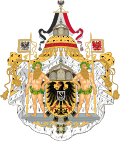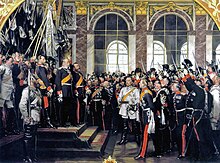German Emperor
| Emperor of the German Empire | |
|---|---|
 | |
 William II | |
| Details | |
| Style | His Imperial and Royal Majesty |
| First monarch | William I |
| Last monarch | William II |
| Formation | 18 January 1871 |
| Abolition | 18 November 1918 |
| Residence | Stadtschloss, Berlin |
| Pretender(s) | Georg Friedrich |
The German Emperor (German: Deutscher Kaiser) was the official title of the Head of State and ruler of the German Empire, beginning with the proclamation of William I as emperor during the Franco-Prussian War, on 18 January 1871 at the Palace of Versailles, and ending with the official abdication of William II on 18 November 1918.
Creation

The title "German Emperor" was carefully chosen by Otto von Bismarck after discussion until (and after) the day of the proclamation. William I of Prussia accepted this title grudgingly as he would have preferred "Emperor of Germany" which was however, unacceptable to the federated monarchs, and would also have signalled a claim to lands outside of his reign (Austria, Swiss Confederation, Luxembourg etc.).[citation needed] The title Emperor of the Germans, as proposed in 1848, was ruled out as he considered himself chosen "By the Grace of God", not by the people as in a democracy.[citation needed]
By this ceremony, the North German Confederation (Norddeutscher Bund) was transformed into the German Empire (Deutsches Kaiserreich). This empire was a federal monarchy; the emperor was head of state and president of the federated monarchs (the kings of Bavaria, Württemberg, Saxony, the grand dukes of Baden, Mecklenburg, Hesse, as well as other principalities, duchies and of the free cities of Hamburg, Lübeck and Bremen).[citation needed]
Full titles
The German Emperors had an extensive list of titles and claims that reflected the geographic expanse and diversity of the lands ruled by the House of Hohenzollern.
William I
His Imperial and Royal Majesty William the First, By the Grace of God, German Emperor and King of Prussia; Margrave of Brandenburg, Burgrave of Nuremberg, Count of Hohenzollern; sovereign and supreme Duke of Silesia and of the County of Glatz; Grand Duke of the Lower Rhine and of Posen; Duke of Saxony, of Westphalia, of Angria, of Pomerania, Lunenburg, Holstein and Schleswig, of Magdeburg, of Bremen, of Guelders, Cleves, Jülich and Berg, Duke of the Wends and the Kassubes, of Crossen, Lauenburg and Mecklenburg; Landgrave of Hesse and Thuringia; Margrave of Upper and Lower Lusatia; Prince of Orange; Prince of Rügen, of East Friesland, of Paderborn and Pyrmont, of Halberstadt, Münster, Minden, Osnabrück, Hildesheim, of Verden, Cammin, Fulda, Nassau and Moers; Princely Count of Henneberg; Count of Mark, of Ravensberg, of Hohenstein, Tecklenburg and Lingen, of Mansfeld, Sigmaringen and Veringen; Lord of Frankfurt.[1][2]
Frederick III
This section is empty. You can help by adding to it. (April 2012) |
William II
His Imperial and Royal Majesty William the Second, By the Grace of God, German Emperor and King of Prussia, Margrave of Brandenburg, Burgrave of Nuremberg, Count of Hohenzollern, Duke of Silesia and of the County of Glatz, Grand Duke of the Lower Rhine and of Posen, Duke of Saxony, of Angria, of Westphalia, of Pomerania and of Lunenburg, Duke of Schleswig, of Holstein and of Crossen, Duke of Magdeburg, of Bremen, of Guelderland and of Jülich, Cleves and Berg, Duke of the Wends and the Kashubians, of Lauenburg and of Mecklenburg, Landgrave of Hesse and in Thuringia, Margrave of Upper and Lower Lusatia, Prince of Orange, of Rugen, of East Friesland, of Paderborn and of Pyrmont, Prince of Halberstadt, of Münster, of Minden, of Osnabrück, of Hildesheim, of Verden, of Kammin, of Fulda, of Nassau and of Moers, Princely Count of Henneberg, Count of the Mark, of Ravensberg, of Hohenstein, of Tecklenburg and of Lingen, Count of Mansfeld, of Sigmaringen and of Veringen, Lord of Frankfurt.[3]
German Emperors (1871–1918)
| Name | Lifespan | Reign start | Reign end | Notes | Family | Image |
|---|---|---|---|---|---|---|
William I
| 22 March 1797 – 9 March 1888 (aged 90) | 18 January 1871 | 9 March 1888 | — | Hohenzollern |  |
| Frederick III [4] | 18 October 1831 – 15 June 1888 (aged 56) | 9 March 1888 | 15 June 1888 | Son of William I | Hohenzollern |  |
| William II | 27 January 1859 – 4 June 1941 (aged 82) | 15 June 1888 | 18 November 1918 (abdicated) | Grandson of William I Son of Frederick III | Hohenzollern |  |
References
- ^ http://web.archive.org/web/20071222124050/http://regiments.org/biography/royals/1859wilG.htm
- ^ Rudolf Graf v. Stillfried: Die Titel und Wappen des preußischen Königshauses. Berlin 1875.
- ^ Titles and styles of William II
- ^ Enumerated as successor of Frederick II who was King of Prussia 1740–1786 but not German Emperor.
See also
- Crown of William II
- History of Germany
- Holy Roman Emperor
- List of German monarchs
- List of monarchs of Prussia
- Family tree of the German monarchs
- Year of the Three Emperors
